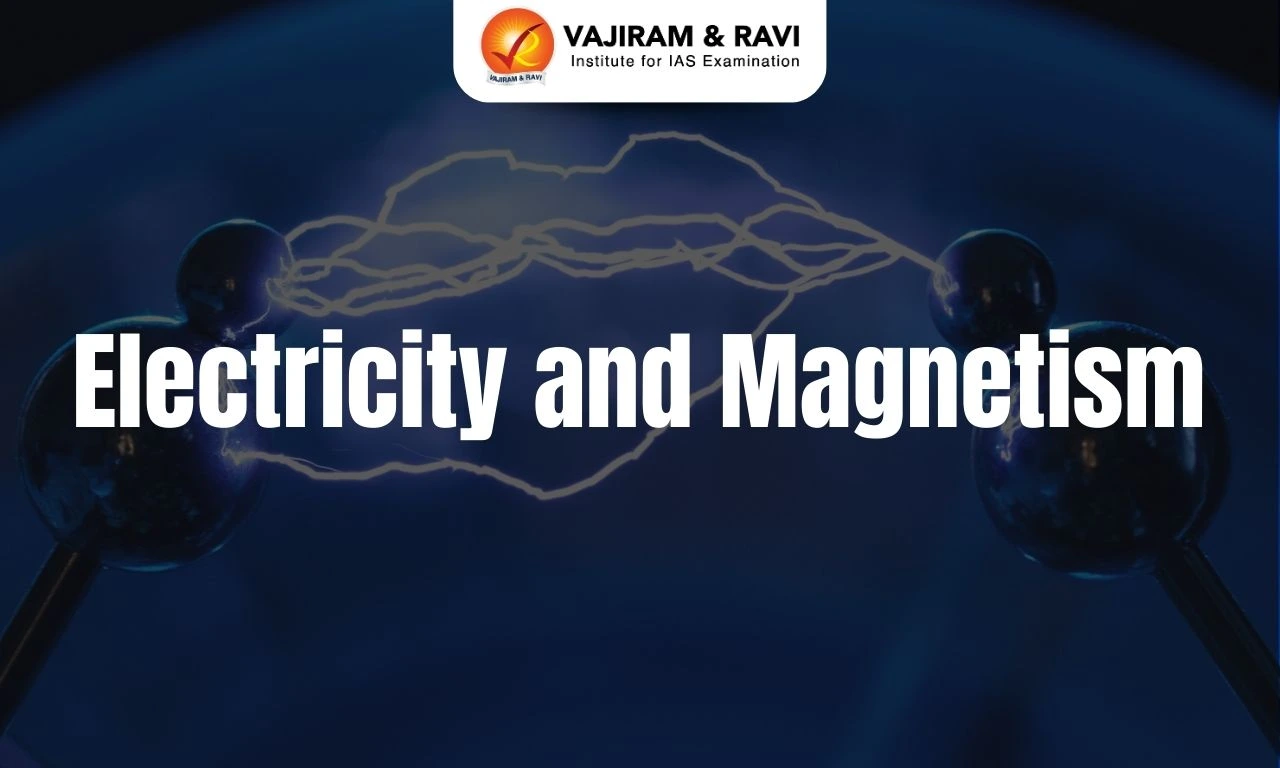Electricity and magnetism come from electric charges and magnetic fields. We see them in everyday things like static electricity and moving currents, as well as in magnets. Together, they make electromagnetism, which is important in technology, transportation, and medicine.
For example, they help generate power, run motors, and even make medical tools like MRI machines work.
Electricity Overview
Electricity is a physical phenomenon that is caused by the presence and movement of electric charges. It manifests itself in a variety of ways, such as static electricity, electric currents, and electromagnetic fields.
- In most electrical processes, electrons are the main carriers of electric charge.
- Ions (charged atoms or molecules) can transport electric charge in some instances, particularly in solutions or gases.
Types of electricity
- Static: Static electricity is a buildup of electric charge on a surface caused by friction and remains stationary until released, like the shock from touching a doorknob after walking on a carpet.
- Current: It is the flow of electric charge through a conductor, like electrons moving through a wire. It can be alternating (AC) or direct (DC) current.
- Alternating current (AC) is a flow of electric charge that periodically reverses direction.
- Direct current (DC) is a flow of electric charge in a constant direction, normally produced by batteries.

Types of Materials
Conductors, insulators, and semiconductors are the materials essential in electronics, with conductors like copper allowing easy flow of electricity, insulators like rubber preventing it, and semiconductors like silicon enabling controlled conductivity.
| Property | Conductors | Insulators | Semiconductors |
| Electrical resistivity | - Low | - High | - Intermediate |
| Ability to conduct electricity | - High | - Low | - Intermediate |
Applications of Electricity
Electricity plays a key role in modern society, powering everything from household equipment to large plants. In recent years, it has played a significant role in transforming vehicles from fossil fuel-based to clean energy.
- Residential and commercial applications: Electricity is necessary in homes and businesses for running equipment.
- Transportation: Electric vehicles (EVs), which include are becoming more popular due to their efficiency and low environmental impact.
- Communication: Electrical power is required for data centres, transmission towers, and networking equipment.
- Medical industry: Important for running diagnostic equipment such as MRI machines, X-ray machines, and patient monitoring systems.
- Manufacturing industry: From powering machinery to managing automation systems in manufacturing plants electricity is required.
- Computers and electronics: Electricity powers personal computers, cellphones, tablets, and other electronic devices.
Magnetism Overview
Magnetism is a phenomenon related to magnetic fields that form as electric charges move. This motion can take various forms, including an electric current in a conductor, charged particles moving through space, or electron mobility in an atomic orbital.
- Magnetic fields cause the deflection of moving charges and exert torques on other magnetic objects.
- Sources of magnetism: Electric current loops and orbiting electrons, which have a magnetic dipole moment and resemble small bar magnets in an external magnetic field, generate magnetic fields.
Magnetic Properties of Matter
The magnitude and alignment of dipole moments have an impact on susceptibility, which determines the magnetic properties of matter. The magnetic materials, based on their behaviour in magnetic fields, are classified into three types.
- Diamagnetic materials: Bismuth and copper, are magnetised in the opposite direction of an external magnetic field, resulting in a repulsive effect when subjected to a weak magnetic field.
- Paramagnetic materials:Aluminium and oxygen, for example, are attracted by an external magnetic field and create internal induced magnetic fields, resulting in a weak attraction.
- Ferromagnetic materials: Such as iron, cobalt, and nickel, have a high positive sensitivity to an external magnetic field and can maintain it once it is removed.

Applications of Magnetism
Magnetism has multiple applications in diverse fields of commerce. The various alloys of nickel, cobalt, and iron are some of the materials with great magnetic qualities; thus, they are used in specialised devices.
- Electric motors and generators: Magnetism is necessary in transferring electrical energy to mechanical energy and vice versa in electric motors and generators.
- Data storage: Magnetic storage devices, such as hard drives, employ magnetic fields to store data.
- Medical imaging:Magnetic Resonance Imaging (MRI) is a medical imaging technique that generates detailed images of the inside of the body by using powerful magnetic fields and radio waves.
- Magnetic levitation: This technology lifts and propels vehicles like trains using magnetic repulsion.
- Compasses: Traditional compasses use a small magnetised needle that aligns with the Earth's magnetic field to aid navigation.
- Electromagnets: They are used in lifting large metal objects in scrapyards and play an important role in scientific equipment such as particle accelerators.
- Magnetic sensors and devices: These include devices such as Hall effect sensors, which are used for position sensing in automotive and industrial applications.
- Credit cards and security systems:Magnetic strips on credit cards as well as certain security systems store and read data using magnetic fields.
Comparison Between Electricity and Magnetism
The two related terms that are thought to have given origin to the study of electromagnetism are electricity and magnetism. It is said that a magnetic field results from current electricity. While electricity is produced by a shifting magnetic field.
| The basis for Comparison | Electricity | Magnetism |
| Basic nature | - Electricity is the result of the flow of charged particles. | - Magnetism is the attractive or repulsive force that arises from the interaction of moving charges. |
| Caused by | -Static (stationary) and moving charges are capable of causing electricity. | - Specifically arises due to moving charges. |
| Monopoles | - Electric monopoles, or single charges, exist. | - Only dipoles are observed. |
| Characteristic feature | - Electricity is an invisible force in nature. | - Magnetism is regarded as a byproduct of electricity. |
| Associated with | - Electricity is associated with positive and negative charges. | - Magnetism is associated with the north and south poles. |
Electricity and Magnetism UPSC PYQs
Question 1: With reference to ‘Li-Fi’, recently in the news, which of the following statements is/are correct? (UPSC Prelims 2016)
- It uses light as the medium for high-speed data transmission.
- It is a wireless technology and is several times faster than ‘WiFi’.
Select the correct answer using the code given below.
- 1 only
- 2 only
- Both 1 and 2
- Neither 1 nor 2
Answer: (c)
Last updated on November, 2025
→ Check out the latest UPSC Syllabus 2026 here.
→ Join Vajiram & Ravi’s Interview Guidance Programme for expert help to crack your final UPSC stage.
→ UPSC Mains Result 2025 is now out.
→ UPSC Notification 2026 is scheduled to be released on January 14, 2026.
→ UPSC Calendar 2026 is released on 15th May, 2025.
→ The UPSC Vacancy 2025 were released 1129, out of which 979 were for UPSC CSE and remaining 150 are for UPSC IFoS.
→ UPSC Prelims 2026 will be conducted on 24th May, 2026 & UPSC Mains 2026 will be conducted on 21st August 2026.
→ The UPSC Selection Process is of 3 stages-Prelims, Mains and Interview.
→ UPSC Result 2024 is released with latest UPSC Marksheet 2024. Check Now!
→ UPSC Prelims Result 2025 is out now for the CSE held on 25 May 2025.
→ UPSC Toppers List 2024 is released now. Shakti Dubey is UPSC AIR 1 2024 Topper.
→ UPSC Prelims Question Paper 2025 and Unofficial Prelims Answer Key 2025 are available now.
→ UPSC Mains Question Paper 2025 is out for Essay, GS 1, 2, 3 & GS 4.
→ UPSC Mains Indian Language Question Paper 2025 is now out.
→ UPSC Mains Optional Question Paper 2025 is now out.
→ Also check Best IAS Coaching in Delhi
Electricity and Magnetism FAQs
Q1. What are the main types of electricity?+
Q2. What is magnetism?+
Q3. What are the types of magnetic materials?+
Q4. What is the role of magnetism in data storage?+
Q5. How do electricity and magnetism relate in electromagnetism?+

















